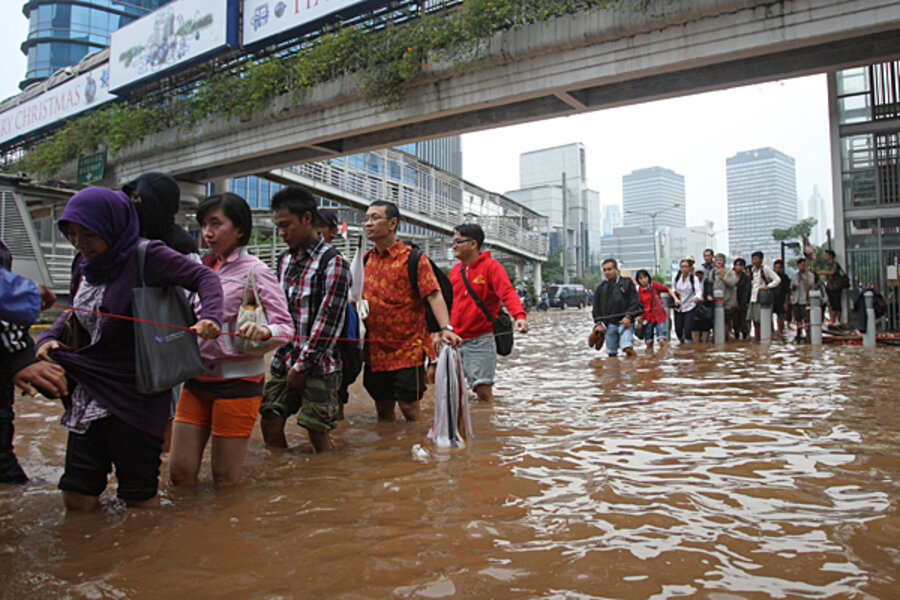Jakarta, Indonesia's megacity of 10 million, is under water
Loading...
| Jakarta, Indonesia
Flooding brought one of Asia’s megacities to a halt on Thursday, as monsoon rainwater in the central business district reached a foot and a half, and almost 10-feet in other parts of the city.
By today, flood-related incidents killed at least 12 people, and close to 20,000 have been evacuated. The government has put the city of 10 million on emergency alert until Jan. 27 and deployed the police and military to assist flood victims.
The flooding is certain to put pressure on the city’s popular new governor, Joko Widodo. He was elected in September based on populist promises to tackle Jakarta’s notorious gridlock, aging infrastructure, and the various problems that come with overcrowding, such as waste disposal and access to clean water.
In recent days both Mr. Joko and President Susilo Bambang Yudhoyono have taken to the streets to assure people they’re serious about fixing the problems that threaten to stall growth in a city at the heart of Indonesia’s economic boom.
Critics say they will need to work fast.
The government did not provide residents with enough warning and many were unprepared for the severity of the flooding, say analysts. Tempers flared after gridlock tied up traffic for hours and forced many people to abandon their vehicles.
“People are angry and frustrated, and always they point their finger at the authorities,” says Endy Bayuni, a political commentator and senior editor at the Jakarta Post newspaper.
He says the government responded well to the disaster by setting up shelters and emergency aid posts. Inflatable lifeboats have been ferrying people and supplies through water up to 10-feet deep. But criticism has been circulating on social media.
“For some people the honeymoon is over,” says Mr. Bayuni, referring to Mr. Joko, who is better known by his moniker, Jokowi. “The appearance of Jokowi in the daily news is getting tiring, and people are saying isn’t it time for you to start working? People want to see results.”
The promise of growth threatened?
While much of the world struggles with economic uncertainty, Indonesia has booked consistent growth of more than 6 percent over the past three years. Much of that growth comes from domestic consumption, but the government is also depending on investment to keep its economy powering ahead.
Economists say the flooding fiasco could put a dent in those prospects.
“Exports and imports and business transactions are automatically stagnant because people aren’t going to work,” says Sarman Simanjorang, the deputy chairman of the Jakarta Chamber of Commerce and Industry.
Television footage on Thursday showed a major traffic circle so inundated with water the streets looked like rivers. Mr. Sarman says the flooding could influence investors in much the same way flooding in Bangkok in 2011 forced investors to consider moving elsewhere.
He estimates that Jakarta could loose up to $200,000 a day if the government doesn’t come up with a plan and set deadline to make sure flooding of this magnitude does not happen again.
Problems pile up
Urban planners say the severe flooding was caused by a combination of factors – subsidence as residents pull up ground water from deep wells, causing the city to sink; poor drainage due to rubbish; and sediment that builds up in rivers and prevents water from flowing out to sea.
“The water management in Jakarta is very bad, and the drainage systems are terrible,” says Yayat Supriatna, an urban planner at Trisakti University. “That makes matters worse everywhere.”
He says the government needs to change its priorities from building roads to focusing on its rivers and catchment areas. A property boom sparked by a growing middle class has also created problems since concrete and asphalt prevent water runoff.
For many here, however, the floods are part of a cycle they’ve grown used to.
“Big floods like this happen maybe every five years,” says Tuti Kartini. “But small ones are normal for us.”
Ms. Tuti has been staying in a mosque serving as a temporary shelter for hundreds of residents in an east Jakarta neighborhood next to one of the city’s 13 rivers. Flooding is so common there that people have added second floors to their homes as temporary refuge.
Along the rivers squatter communities have hampered the flow of water and dredging projects have not materialized, despite support from international donors. Mr. Supriatna says residents need to stop throwing their trash into the rivers, but the government also needs to support programs to clean the city’s waterways.
Since taking office Mr. Joko has suggested building a deep storm tunnel that will help with water runoff, and, in recent days, has voiced support for a river widening project – a proposal that has met fierce protest in the past from riverside dwellers who would likely be evicted.
Whatever he does, residents like Tuti will be watching, she says: “Hopefully, Jokowi can change everything, so it’s completely nice to live here.”







